Putting economic growth at the service of human development in Djibouti
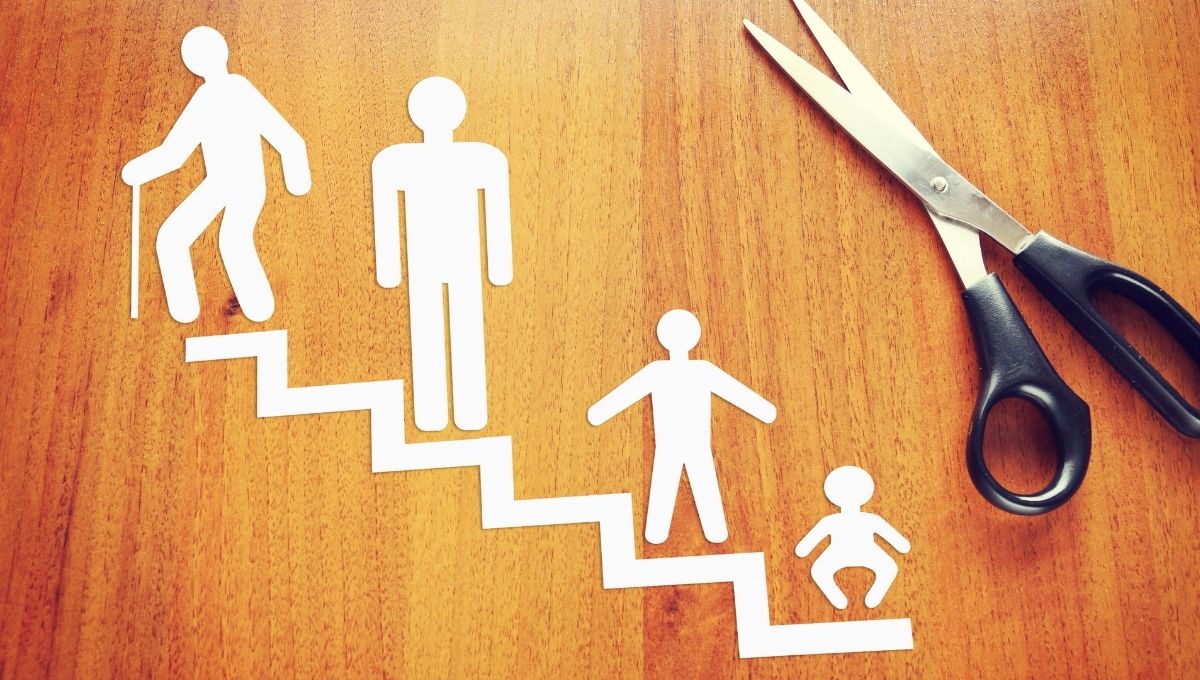
Written By: Omar Ahmed Omar
Date: 2021-12-23
Views: 7424
Source:
The year 2020 was marked by an unprecedented crisis that has weakened countries around the world in terms of health, economic and social issues. As many papers in the African Review of Economics and Finance (AREF) showed, on the economic front, this crisis seems to have far more serious consequences than the financial crisis of 2009. The Djiboutian economy, primarily driven by demand, including Ethiopia, has contracted as a result of the Covid-19 pandemic. After a slight decrease in 2019 (7.7%) compared to 2018 (8.4%), economic growth fell sharply in 2020 (1.4%). Obviously, the COVID-19 crisis has had real and considerable effects on African economies in general, but the Djiboutian economy appears to be doing quite well, thanks to the government’s response which has mitigated the pandemic’s impacts and growth has long been expected to resume in late 2021 (around 9.9% according to the African Development Bank).
Now that the year is almost at an end, we revisit the development strategy pursued by the Republic of Djibouti in the light of human development indicators. The Djiboutian economy is essentially based on the tertiary sector and port activities. The practitioners and policymakers seem to agree on the non-inclusive nature of its growth. The COVID-19 pandemic may have revealed the true nature of Djibouti's growth, considered in 2021 to be the most accelerated in Africa. In reality, this rapid and strong recovery indicates that this is volatile and non-resilient growth that does not emanate from local production.
After examining the nature of recent economic progress through the GDP, as the main growth indicator, we will highlight its limitations.
Strong economic growth?
Maintaining high growth over a long period of time could be evidence of a good strategy, but not necessarily of socio-economic development. Indeed, the growth rate constitutes a valid and relevant aggregate indicator of the performance of an economy. The growth rate constitutes a valid and relevant aggregate indicator of the performance of an economy. A retrospective look at the context in which this performance is achieved suggests that the high growth episode was characterized by active government intervention. In particular, state investments in infrastructure were behind this performance. However, these investment levels cannot be sustained over the long term because of concerns about debt sustainability in Africa and globally. Likewise, state interventionism could hamper the development of the private sector.
As the World Bank also points out, the recent development of the Republic of Djibouti has been without economic transformation. It is essentially extensive growth based on the accumulation of physical capital.
Thus, Djibouti's development strategy is based on a growth model based on the accumulation of physical capital, financed by debt. Consider labour productivity. Although contested as a definitive measure of labour progress, in Djibouti, this measure reflects other fundamental weaknesses, such as a lack of business innovation. While this strategy makes it possible to stimulate growth in the short and medium-term, it is not sustainable in the long term. Moreover, having a development strategy is not just about the good performance of economic growth. The expanded definition refers to a set of coordinated public actions that would truly enable Djibouti to raise the standard of living of Djiboutians and become, within a generation, an upper-middle-income country.
… But without prosperity
Despite the efforts, the levels of poverty, unemployment and inequality remain high and the various initiatives supposed to improve living conditions have not led to convincing and lasting results. After all, the achievement of strong growth is not an objective in itself, rather a means to achieve a much more important goal: human development.
Figure 1: Comparative levels of human and economic development of several African countries
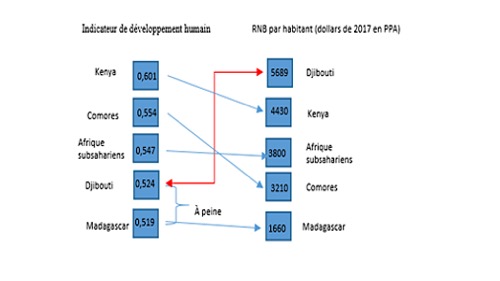
Source: Prepared by the author using data from the UNDP and the World Bank.
The analysis of the level of human development really questions the development strategy. Djibouti's level of human development is well below that which its level of aggregate income, measured by gross national income, would allow. This gap is significant compared to other countries which have much higher levels of human development than Djibouti for a lower gross national income (cf. Figure 1). Djibouti's standard of living is close to that of a country like Madagascar (0.519) while its gross national income is 6 times higher (cf. Figure 1).
Between 2000 and 2019, the HDI of Djibouti went from 0,360 to 0.524, an increase of 45%. Despite this notable progress, this score did not allow Djibouti to move out of the category of countries with low human development. Yet over the same period, gross national income increased by 221%. Over the same period, for example, the Comoros raised their level among the category of countries with average human development with a much less significant increase in national income. As shown in recent studies, the level of human development in Comoros rose from 0.465 to 0.554, an increase of 19.1%, while its national income grew by only 9.3%. The comparison of the performance of the Comoros in terms of human development compared to Djibouti highlights the difficulty of the latter in reconciling macroeconomic progress in terms of growth and human development. This shows that it is possible to improve the level of human development with a relatively low but sustained growth rate. This means that this country devotes more attention to human development.
A similar observation could be made by examining the case of Kenya, as the human development report has recently done. This country increased its HDI from 0.461 in 2000 to 0.601 in 2019 to rank among countries with an average human development level. Even if these two countries started out with higher HDIs than Djibouti's, the credit for their progress goes to the nature of the reforms undertaken.
In the case of Djibouti, two explanations can be put forward to explain the contrast observed between the boom in growth and poor human development. First, as mentioned above, this growth is not based on internal activities but is essentially driven by sectors with high capital intensity and low labor intensity. Then, the human development effort is handicapped due to a strong increase in inequalities between social strata but also between the capital and the interior regions. As the Human Development Report pointed out: “the issues that are growing in importance in many countries are not so much the size of the entire pie, but the relative size of the shares”. There are, of course, deeper questions about global and local forces at play, as shown in a recent book, Property, Institutions, and Social Stratification in Africa.
Growth rate and upper middle income
Table 1: Growth Path Necessary
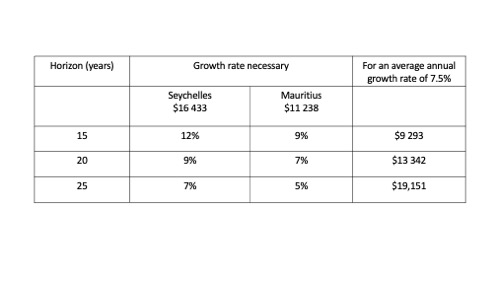
Source: Author's calculation.
Setting aside debates about unreliable growth statistics in Africa for a moment for the sake of analysis, from equation (1), one can calculate the number of years it takes to achieve the desired level of per capita income from the average annual growth rate ( and the current per capita income. Also, it would be quite possible to deduce the average annual growth rate needed to achieve the target per capita income.
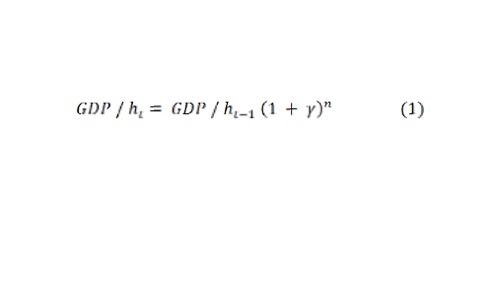
We can apply this formula to answer, for example, the following question: if the economic growth rate of Djibouti is maintained at the average annual rate of the projection period of the direction of the economy (i.e. 10, 1%) and based on its GDP per capita in 2019 (i.e. 3 406$), how much will the GDP per capita in 2035 i.e. (in 15 years)?
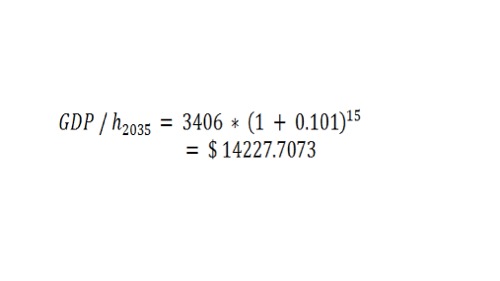
In the space of 15 years (by 2035) and under the growth assumption adopted, the country could reach a higher middle-income level, i.e., 14,227.7073. In other words, Djibouti could approach in 2035 the standard of living of Seychelles of 2018 (16,433 $) for example and exceed that of Mauritius of 2018 (11,238 $).
We can also deduce from this equation the number of years necessary to reach the level of GDP per capita of Seychelles in 2018 (i.e., 16,433 $) if we use the average annual growth rate for the period 2021-2025 according to the projections.
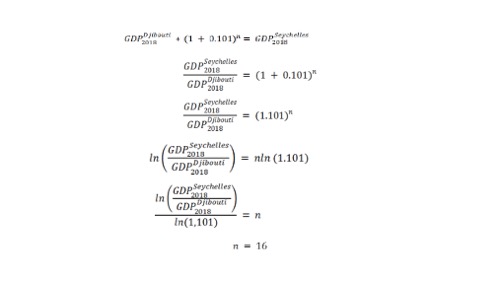
Djibouti, through its long-term strategy (Vision 2035), plans to triple the level of per capita income by 2035 and seeks to raise and is in the category upper middle-income countries.
So, it is clear that to achieve such a standard of living in 15 years, you need an average annual growth rate of 12%. Fortunately, it will be possible to achieve such a performance if the factors of production are used optimally because of the untapped potential. Growth alone is not enough. As many studies published in AREF have shown, even quality growth is not sufficient. Questions about decent work, shared wealth, and inclusive sustainability remain elusive.
Conclusion
While growth can inform a country’s development strategy and the performance of its economy, it hides other essential aspects of development. It is important to stress that it is only a necessary and not sufficient condition. A less descriptive analysis of recent economic developments suggests that the path ahead requires a change in the growth model while preserving and consolidating achievements. Hypothetical questions provided insight into the nature of the challenges.







